3 min read
Honchō Scoops Up Two UK Search Awards!
It’s official, we've added not one, but two shiny trophies to our awards cabinet! We’re over the moon to share that we’ve triumphed at the UK Search...
Shopify is one of the most popular e-commerce platforms available currently with almost 50,000 websites in the UK using the Shopify platform. This is thanks to its easy to use navigation, a great collection of exciting themes and a tempting pricing structure which attracts small start-up businesses and major brands alike, often resulting in a wealth of success.
However, websites that use Shopify have also experienced some problems with SEO due to the way in which the platform is structured. In this article, we dive deeper into these issues and find examples of how Shopify causes major problems to websites’ SEO*.
*Please be aware that we have reviewed issues that would occur for users of Shopify without further development work going into the platform
One of the limitations of Shopify was the inability to edit the robots.txt file, which prevented website owners from directing to Google which parts of the site to not index and other directives.
However, since June 2021, Shopify has updated their platform to enable users to edit the robots.txt file.
All Shopify sites start off with the default robots.txt file which Shopify states is suitable for most of the sites that will be on their platform, but if users wish to, they can now edit it.
Users are able to make changes to the robots.txt file by accessing the robots.txt.liquid theme template.
You can now make the following changes to the robots.txt file:
How To Access The robots.txt.liquid Theme Template:
While this is a welcome change for website owners, Shopify has given warning to those who edit it that this is “unsupported customization” and that the Shopify support team will be unable to help with edits made. Shopify warned that “Incorrect use of the feature can result in loss of all traffic”.
One of the main drawbacks of using the Shopify platform is that they have predetermined hierarchical structure that your website and URLs have to follow. Following a logical structure on your site is essential for performance in search, as it indicates a clear path for both users and search engines. Therefore, if you want your site to be fully optimised, having control of your site structure and being able to create custom URLs is essential.
On Shopify, every page you create on your site will have a folder that cannot be changed, for example:
Because of this issue, you are unable to create a sub-category of the root collection, you will have to create a new category altogether. This creates multiple URLs for the same page, leading to further problems. There’s no workaround for this.
One of the major issues that arises from using Shopify is the duplicate content created due to its internal linking structure. Multiple URLs are present for the same page and the same content which means that duplicate content is produced. We found examples of this when looking into Nicce Clothing and evaluating their HTML tags.
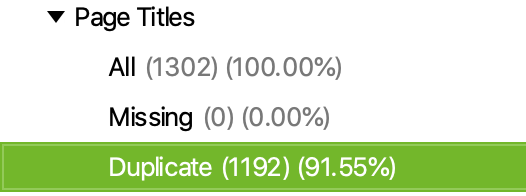
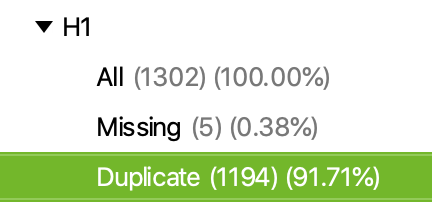
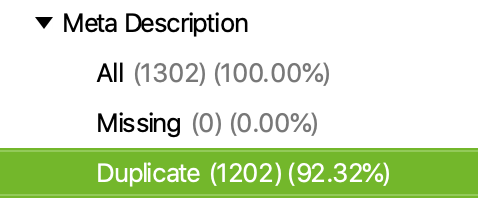
There are multiple paths reaching to the same product page. This creates duplicate product pages with the same item and content but a different URL. Below are some examples of this occurring.
All of these URLs:
https://www.nicceclothing.com/collections/accessories/products/nicce-unisex-ace-neck-pouch-black
https://www.nicceclothing.com/collections/bags/products/nicce-unisex-ace-neck-pouch-black
https://www.nicceclothing.com/products/nicce-unisex-ace-neck-pouch-black
Lead to the same page (below) with the exact same content.
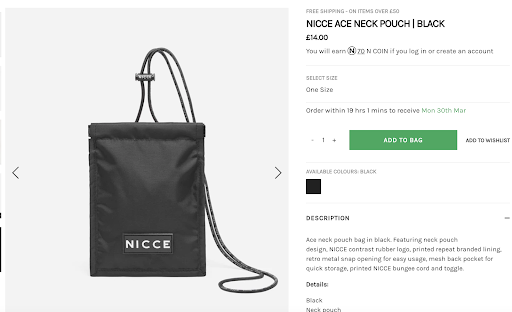
Duplicate content can be very problematic for search engines as they are unable to determine which of the duplicate pages should be returned in the SERPs. This leads to cannibalisation, making it harder for each of the pages to rank and the search engine giving the preference to other webpages.
NICCE has combated this with canonical tags to show search engines the preferred version of the page. By having a canonical tag, Google will essentially count both of these duplicate pages as one and will make the canonicalised pages non-indexable.
This can delay the indexing process as it makes it more difficult for search engines to discover your pages. Google is likely to follow the pages which follow the structure. So when trying to find a product page, it is likely to go through the direction of the home page, category page and then to the product page. But this will have a different URL if it went directly to the product page. Even though the canonical tag will direct Google from the long URL to the product page, this can delay the indexation process.
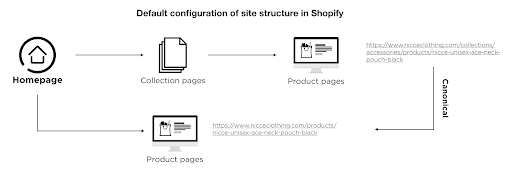
Another issue caused by duplicate pages and canonicals is index bloat. Index bloat is when there are too many pages on a website being indexed which do not add any substance to the website. In this case, it’s these duplicate pages which are canonicalising to other pages. Even if Google is being told to serve 1 page, avoiding duplicate content, it still crawls all of those pages. This leads to SEO problems as it wastes crawl budget, decreases the original quality of the domain and lowers the ranking potential of the other pages.
No matter what pricing plan you are on, Shopify has a set Robots.txt file which you cannot edit or add to. This can prove to be problematic especially if you have a large and complex catalogue of inventory with multiple brands, product types, variations and multi-faceted navigations. You are unable to control which pages the search engines can crawl for indexation or to brand a page as a nofollow. Your website will be stuck with the following configuration.
Tag pages allow the user to filter the products available within that category according to their requirements. This is especially useful if you have a large and varied inventory. However, with Shopify, you are unable to create content for these pages. This can be problematic if you have different variations of the same type of product, for example, a clothing company that wants to have a separate page for zipped hoodies and pull-over hoodies. You can create these different pages, but it is difficult to add content to these sub-category pages. The example below shows an example of a root category page and a tag page which comes under this category with the exact same content.
www.militarykit.com/collections/jackets:
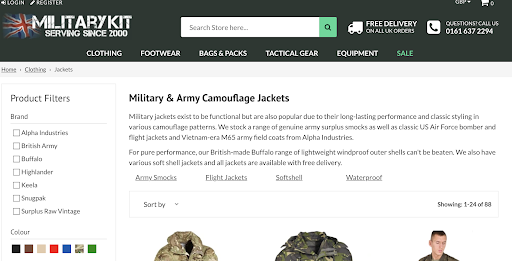
www.militarykit.com/collections/jackets/british-army:
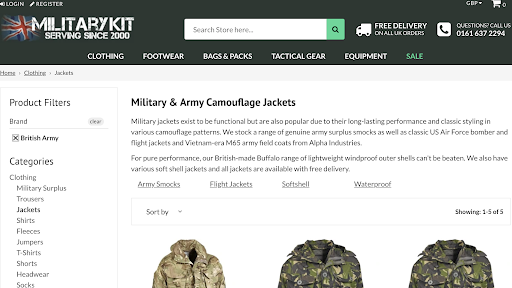
Unfortunately, there is no easy way to add custom content to the tag pages through the admin panel. You will need to add code for every tag, which can be time-consuming and increase the length of the code. For adding custom content to the tag pages, without creating duplicate page titles, you add the following code to your collection.liquid file.
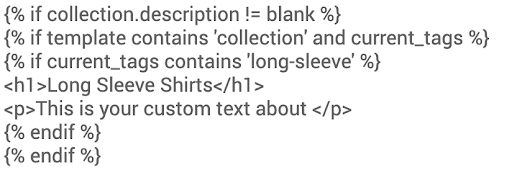
One of the main reasons why people love Shopify is the thousands of themes and apps you can easily add to your website to change the layout or increase functionality. These 3rd party apps and themes are great for functionality and being able to do more with your site, however, they can potentially have a disastrous impact on your SEO.
If you start adding lots of 3rd party apps without understanding how it works or impacts your site’s SEO, this could lead to your rankings plummeting. Therefore, it is essential to make sure you test and analyse how it works within your site.
Themes can also have a big impact on your SEO, as they act as an overlay across your whole site, potentially having a huge impact on performance. Sitespeed is one of the most crucial factors in SEO. Themes on Shopify, especially ones which add functionality to your website, use external Javascript and CSS files. While this may be necessary, these files can cause lower page load speeds, massively impacting performance in the SERPs.
We analysed the site speed of GymShark, one of the major brands who use Shopify. You can see their results for both mobile and desktop below.
GymShark Mobile Speed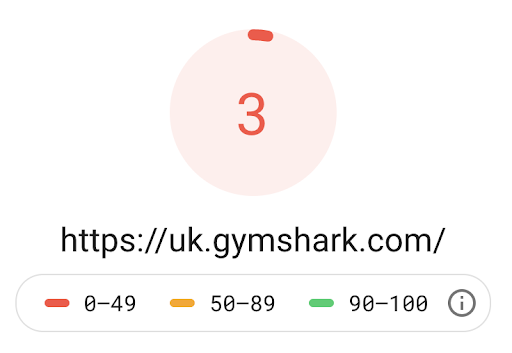
GymShark Desktop Speed
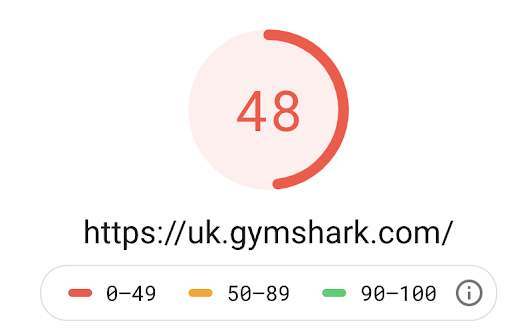
Mobile traffic is higher than ever before but their mobile loading speed was exceptionally low. Suggestions to improve load speed include removing unused CSS and minifying JavaScript, which is what the widgets and themes use. They could also eliminate render-blocking resources. Render-blocking is due to JavaScript and CSS files in the script queue, causing the pages to load slowly.
The internal structuring of the site is a fundamental issue of Shopify which you cannot get around. A similar issue is that Shopify does not provide you with log file data, which is a record of every request made to your hosting web server.
Using log files, we can:
This is why the log file data is essential to help gain an accurate view of how search engines crawl your website. Therefore, not being able to access the log file data can restrict you heavily from being able to make technical and on-site SEO improvements.
The page title and meta description on a page don’t have a direct impact on SEO, however, it can have a significant impact on the click-through rate from the SERP. Therefore, it is important for pages to have an optimised page title and meta descriptions to attract customers to their site.
When writing a meta description or page title, character-limit is a main consideration. Google allows for up to 920 pixels in the meta description, which can be up to 158 characters, depending on the letters used and upper/lower case characters.
However, Shopify bases their cutoff limits based on character count. As the character limit is different from the pixel limit, it can often mean titles and metas are too long and are truncated in the SERPs.
This is not a major problem and an easy way to work around this is to use tools from external websites such as SEO Mofo which gives you a preview of how your meta information looks on the SERP. You can write and amend your copy on this site so that it does not surpass the pixel limit. However, it is inconvenient to have to go to an external website and it can be time-consuming if you have already written the copy.
Another issue from Shopify that can be very time consuming to fix is that you can only set up redirects on a 1 to 1 basis. This means that you can only set up a redirect for one URL at a time and if you want to change a batch of URLs you will have to do each of them individually.
This can be especially problematic for e-commerce businesses who have a diverse inventory who often make changes. For example, if you stop selling a particular type of product, then you will have a lot of products that you will have to discontinue. To avoid a poor user experience, you don’t want the customer to end up on a product or category page of a discontinued item, you will want to redirect this traffic to the related category or product page instead.
However, as you can only change the URLs one at a time, it can be a very time-consuming task. While 301 redirects are being implemented, users can continue to land to the product page of a discontinued item.
Shopify is one of the most popular e-commerce platforms available currently. Its ease of use and simplicity are its main selling points, but also a source of many SEO problems.
Is Shopify good for SEO? The short answer, no. A lot of times there are workarounds for these issues but this can be time-consuming and technical. Some issues don’t even have a workaround, like forced internal structuring, duplicate pages, delayed indexation and no access to log files. These fundamental problems can heavily impact your website’s SEO. Despite this, Shopify remains to be ideal for fresh startups looking for an easy way to get going in a less competitive market.
If you are thinking of starting your own Shopify store or planning to migrate to or from Shopify, then drop us a message or give us a call on 01438 870220 and we will be more than happy to chat about how we can help you!

3 min read
It’s official, we've added not one, but two shiny trophies to our awards cabinet! We’re over the moon to share that we’ve triumphed at the UK Search...

5 min read
Understand ecommerce attribution models which attribution models can maximise your marketing efforts and ROI.

3 min read
Explore how social commerce is changing the way we shop online, blending social interactions with digital commerce for a seamless buying experience.